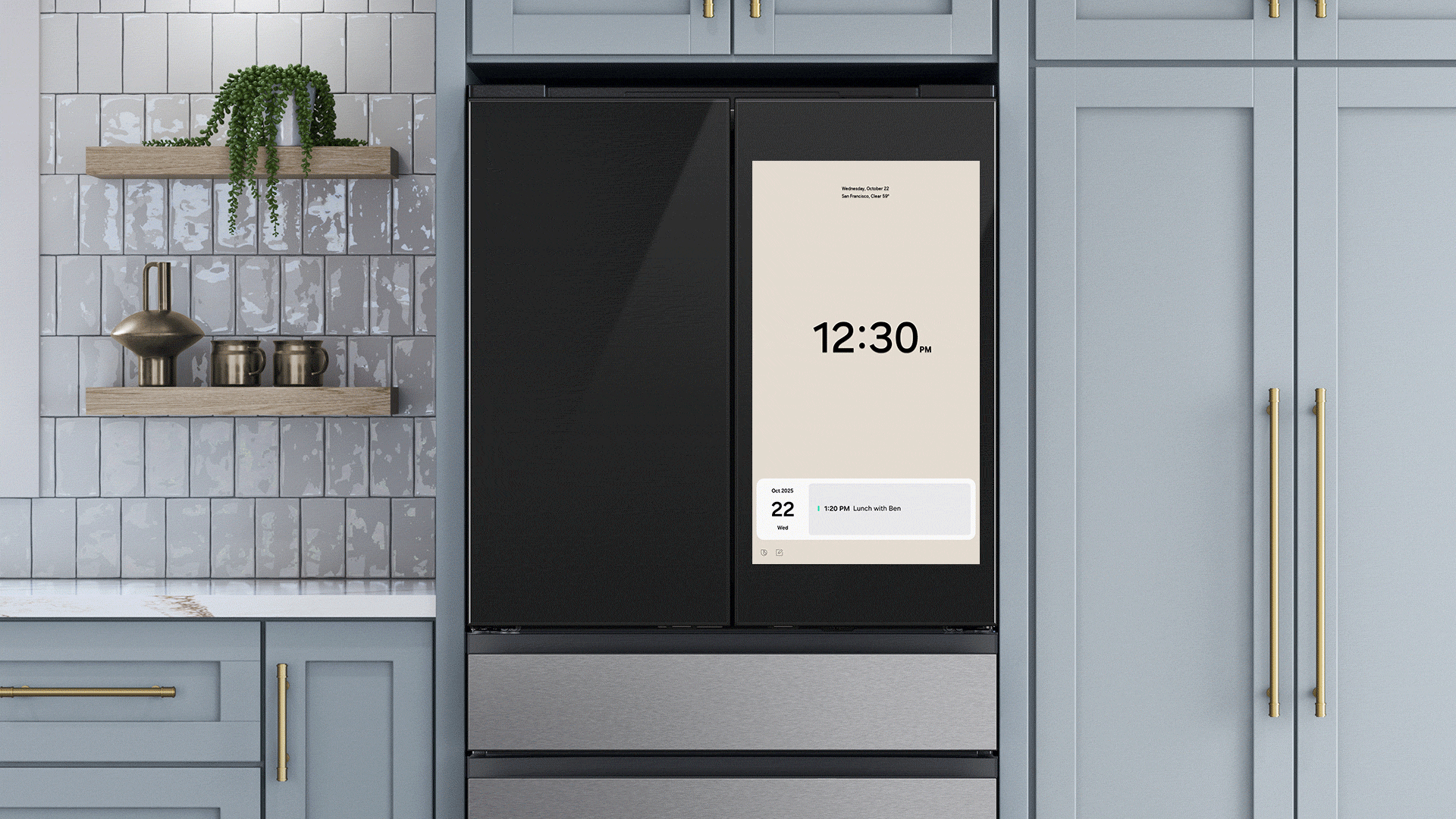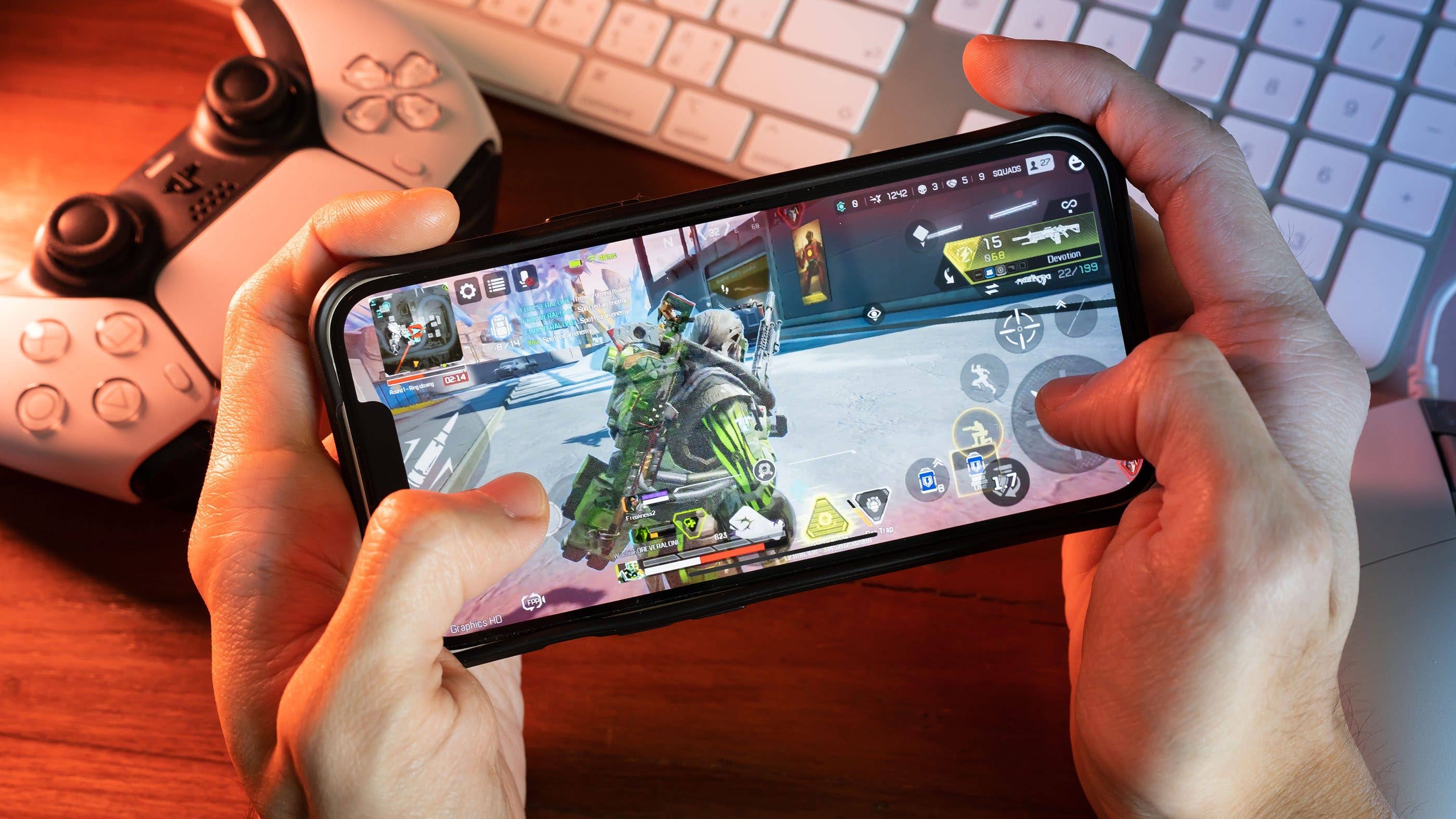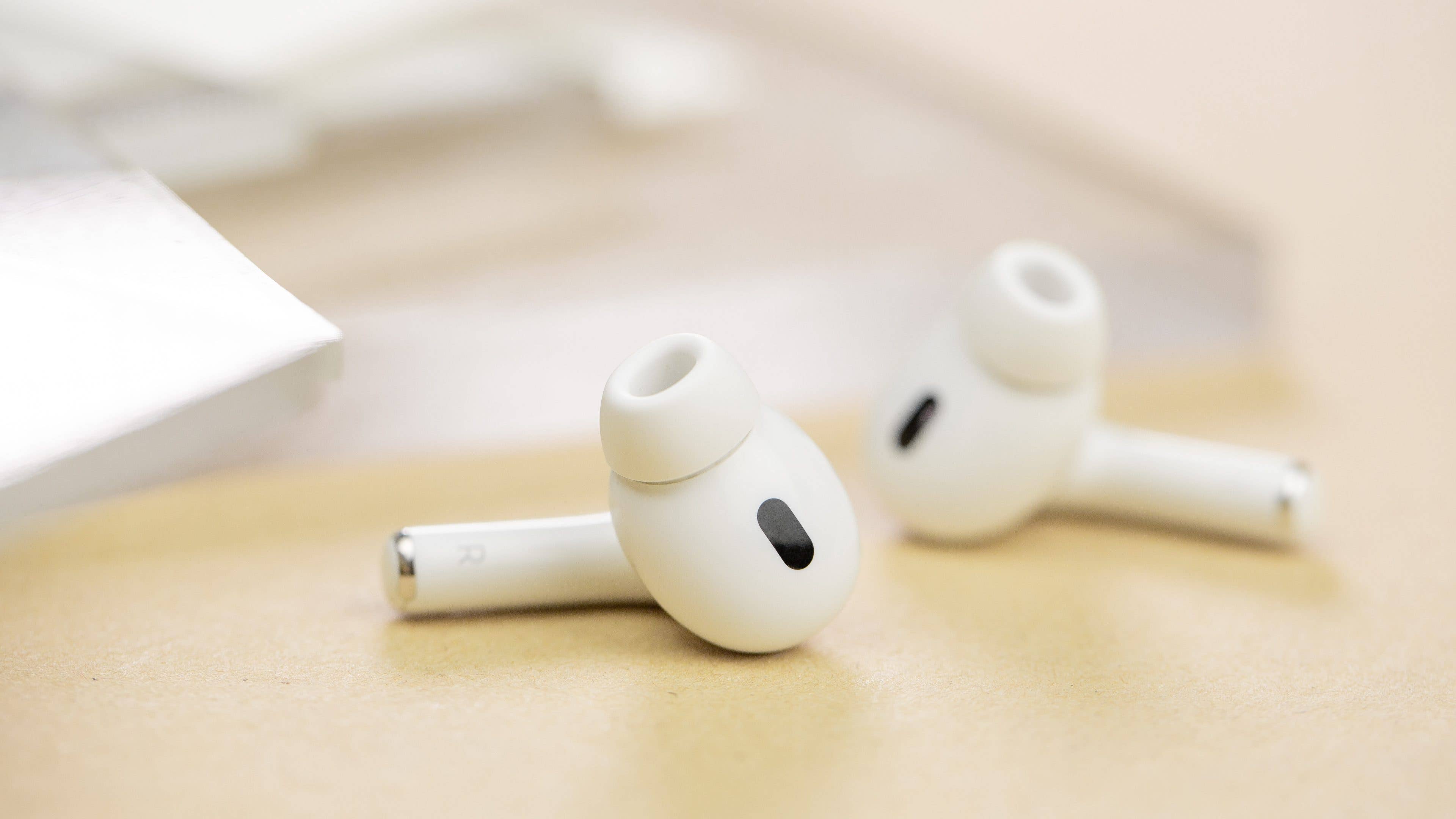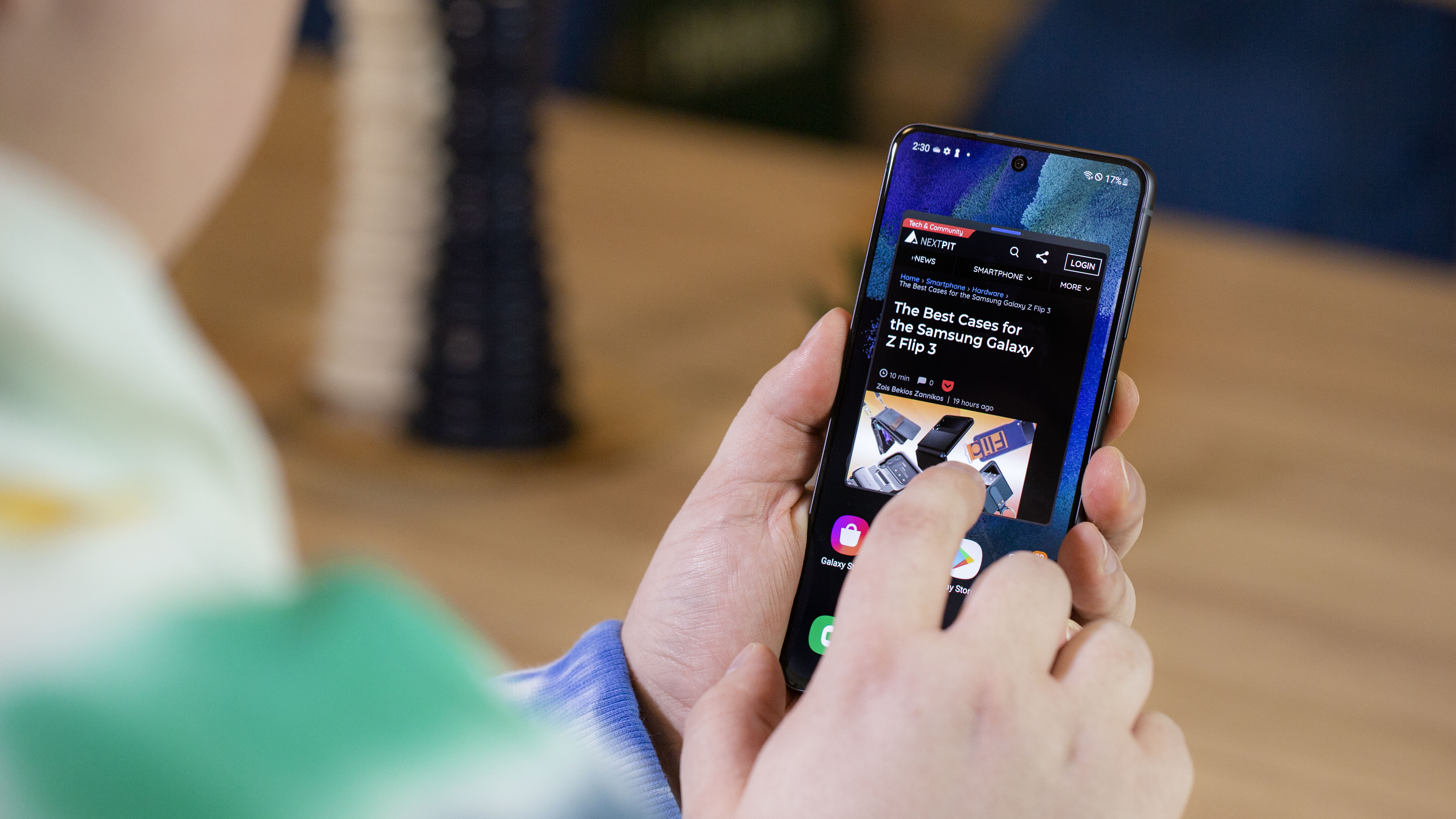
View the screen time of your Samsung smartphone
Screen time is an important metric in Android’s digital wellness settings, and Samsung offers a version that’s a bit more customizable than Google’s native solution. My colleague Ben has written a comprehensive guide to show you how to check screen time on your Samsung smartphone. But here I offer you the condensed version:
- Open Settings.
- Go to Digital Wellbeing and parental controls.
- Tap on Digital Wellbeing.
- Under Your Goals, select Screen Time.
- There you’ll see the cumulative screen time for the last few hours, days, and weeks.
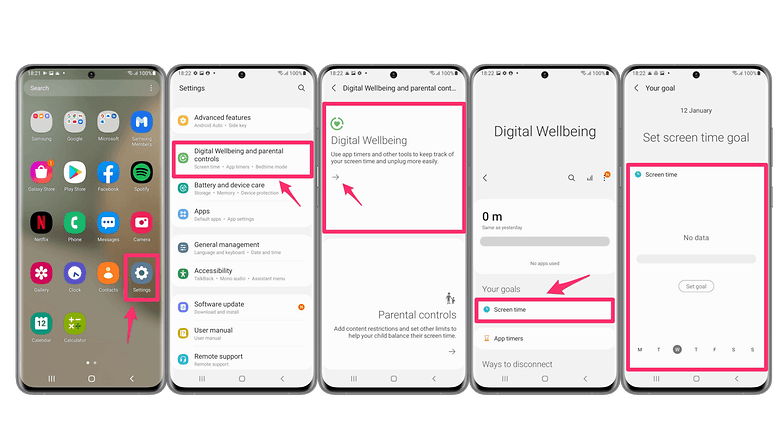
If you want to keep an eye on your screen time, you can also activate a widget. It allows you to display statistics on your home screen, which will be regularly updated. Follow these steps to activate the widget:
- Long press on the home screen.
- Select Widget.
- In the selection, you will find a widget called Screen Time.
- Choose one of the designs and add the widget to your home screen.
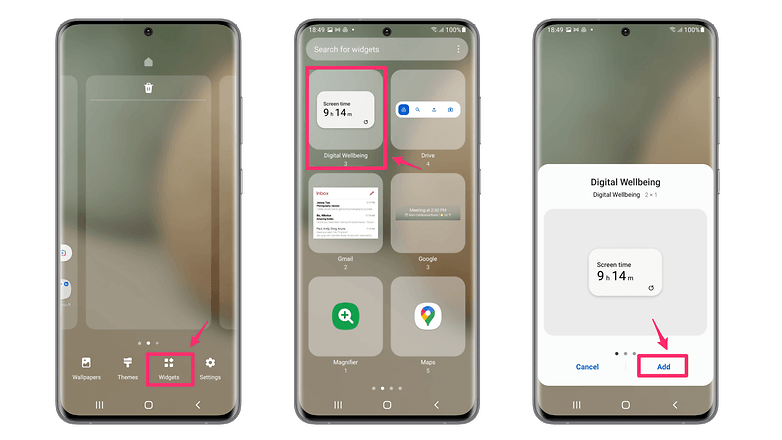
Enable Find My Mobile feature if you lose your Samsung smartphone
Find My Mobile is a feature that could be a lifesaver if you’ve forgotten your unlock code for your Samsung smartphone or worse, misplaced the handset. Once again, my colleague Ben has dedicated a tutorial on how to activate Find My Mobile on your Samsung which I’ll let you refer to for additional details.
On the Find My Mobile website, you can log in with your Samsung account and access the following functions:
- Make the smartphone ring
- Lock the smartphone
- Track smartphone location
- Erase smartphone data
- Create a backup
- Receive calls and SMS
- Unlock the smartphone
- Extend battery life
- Manage parental control features
To activate these features:
- Go to Settings.
- Go to Biometrics & Security followed by Find My Mobile.
- Enable Remote unlocking, Last known location transmission, and even a tracking feature when the smartphone is turned off
And if you still can’t get enough of dear Ben’s guides, do take note that he also wrote a guide on unlocking your Samsung without a PIN or password.
Customize the Material You theme for One UI
This feature is specially reserved for One UI 4 & 5 users since it involves setting the dynamic Material You theme, which is available in Android 12. This feature allows you to adapt the interface color to the dominant color palette of your wallpaper.
On your compatible Samsung smartphone:
- Go to Settings and then select Wallpaper & Style.
- Tap on Color Palette and choose the palette of your choice.
You can also choose to apply this theme to application icons. But in 99% of the cases, only the icons of the native applications of Samsung and Google will be modified.

Switch from Samsung Free to Google Discover on the home screen
The integration of the Google Discover news feed on the left pane of the home screen is now democratized on Android. There are some manufacturers who still put up a bit of resistance, Samsung included, as they offer their Samsung Free feed (formerly known as Samsung Daily) by default to its users.
Regardless of any debate about Google’s dominance of the Android market, here’s how to replace Samsung Free with Google Discover on your home screen:
- From your home screen, perform a long press (not on the icons).
- In the editor, swipe right.
- Select Google Discover and return to the home screen (swipe up or home button) to confirm your choice.

Change the icon layout on your Samsung home screen
Well, it’s far from being a hidden function but sometimes, going back to the basics can be just as useful. If you’re a neat freak or want a more feng shui-friendly home screen, you can change the layout of the application icons, the size of the grid (4×5 / 4×6 / 5×5 / 5×6) of the home and application drawer, etc.
Just go to Settings and then Home screen or, as in the previous steps, long press on the home screen and then select Settings.
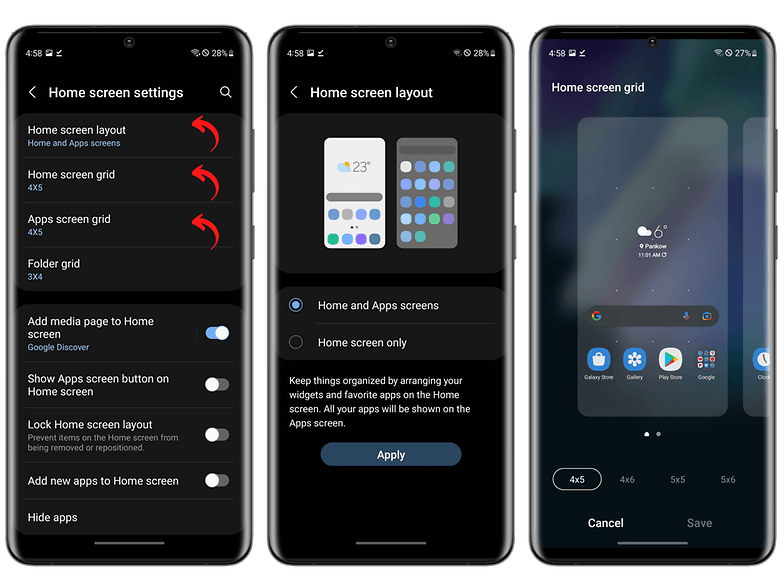
Adding widgets to the lock screen in One UI
Like the home screen, the lock screen of your Samsung smartphone can be customized. In particular, you can add widgets that appear when you tap the clock on your always-on display or lock screen. You can’t add just any widget though as only a handful of apps are compatible. You can also change the vertical layout of the widgets, according to your preference based on your priority.
To add widgets to the lock screen of your Samsung smartphone:
- Go to Settings and then Lock Screen.
- Tap Widgets and choose the widgets that you want to display.
- Arrange the vertical layout of the widgets in order of their priority.
- Lock your smartphone and, from the lock screen, tap the clock to display the widgets.

Hide or unhide an application in One UI
With One UI, you can “hide” applications on your Samsung smartphone. The app will no longer be visible from the home screen and app drawer. To hide an application on your Samsung smartphone:
- Long press the home screen.
- Select Settings.
- In the Home Screen Settings, select Hide apps.
- Choose the apps you want to hide and press OK.
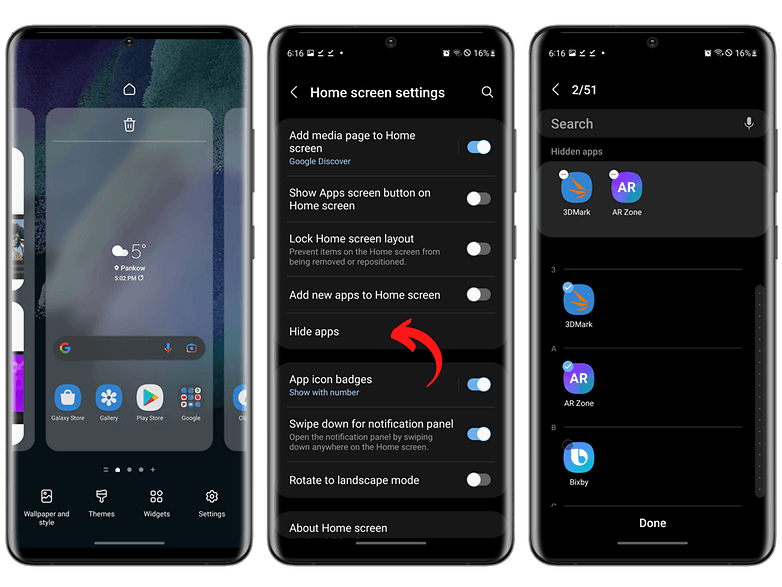
We might as well warn you that you just have to search for the name of the app to find it. And you can always “unmask” an application by following the same method and simply removing the concerned application from the list of hidden apps.
If you really want to hide an application, it is better to use the Secure Folder function. However, you will first need a Samsung account for that. This “secure folder” is hidden from the home screen and the application drawer and its access is protected by a password/biometric fingerprint.
To hide an application or file in Secure Folder:
- Swipe down to display the quick access menu.
- Tap the Secure Folder shortcut (or add it by editing the Quick Access menu).
- Return to the Home screen and select the Secure Folder icon.
- In the Secure Folder, tap the “+” sign to add an application/file.
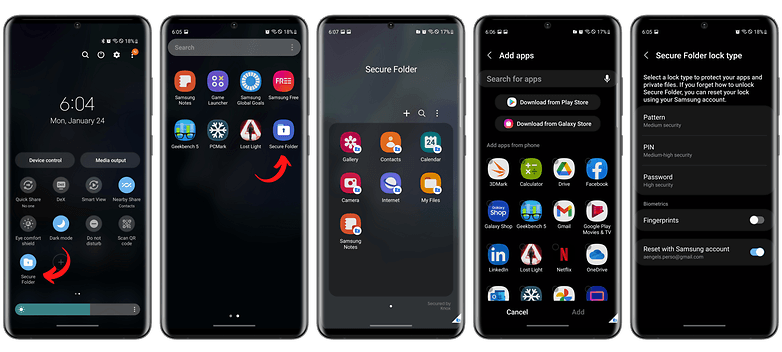
Use the Wireless Powershare feature of your Samsung smartphone
Wireless PowerShare is a feature in One UI that allows you to transform Galaxy smartphones into wireless chargers. It’s simply the name that Samsung has coined its reverse wireless charging technology.
You can charge your Galaxy Watch or Galaxy Buds or any Qi-certified device by placing it on the back of your Samsung smartphone. Just enable the Wireless Powershare feature from the Quick Access menu (if the icon is not listed as a shortcut, you will need to add it by editing the Quick Access menu).
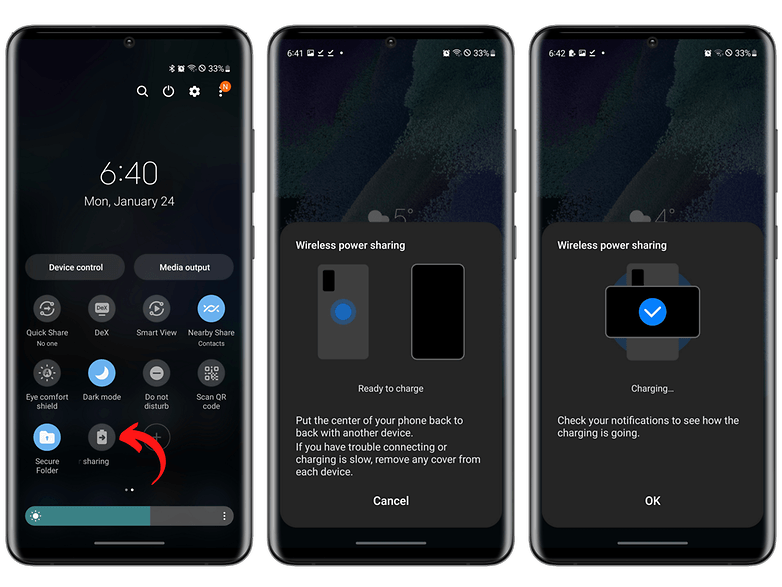
Customize the Side Panel menu in One UI
Side Key is a feature of One UI that allows you to have a side shortcut pane hidden along the edges of your Samsung smartphone’s screen. Double tap or long-press the translucent bar on the right edge of your screen and you’re good to go, where you can add your favorite apps and even app pairs that will open in split screen directly.
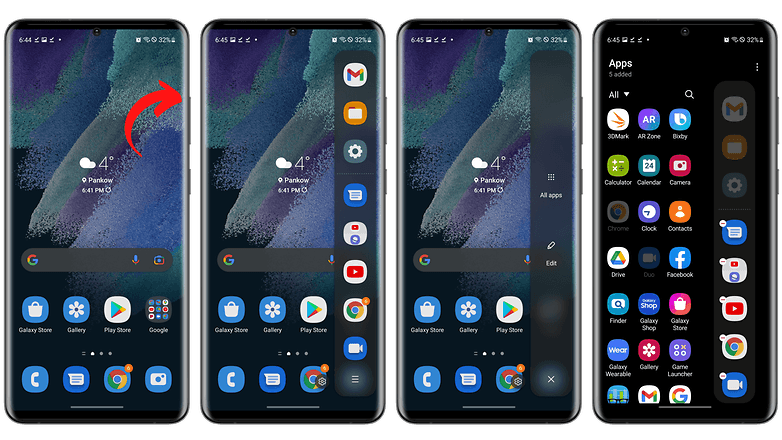
Enable dual messenger to use two WhatsApp accounts
Messaging applications that are associated with the phone number normally accept only one line in the profile. The Dual Messenger function allows you to “clone” applications such as WhatsApp, Signal, and Telegram, which in turn allows you to use, for example, the personal number and work number in the corresponding instance of the application.
To activate this function:
- Go to Settings.
- Select Advanced features followed by Dual messenger.
- Choose the corresponding messaging application.
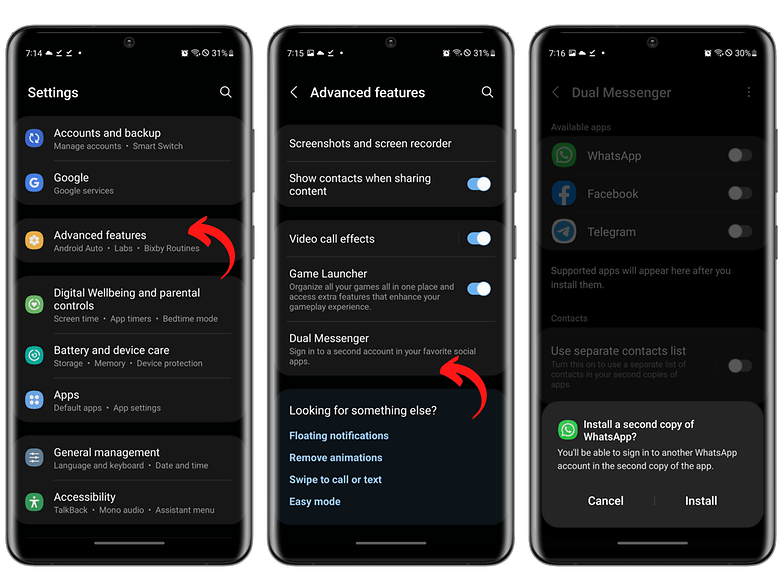
After a few seconds, the app list will display a second icon for the selected app, highlighted by an orange symbol for the secondary account. After that, you need to follow the registration procedures of the service as usual.
Disable (or reassign) the Bixby or power button
The Bixby virtual assistant is not exactly a hit with everyone. If you have a device with the dedicated Bixby button but don’t want to use the assistant, you can set it up as a shortcut to other tools. But this also applies to owners of newer Samsung Galaxy smartphones.
The latter lacks a dedicated Bixby button, but the power button remains linked to the Samsung assistant by default. It has gotten to the point where Samsung has to provide a tutorial on how to turn off your smartphone because a long press on the power button, the universal gesture to turn on/off your phone, activates Bixby. Good for you, Samsung. Really, bravo!
To reassign the power button:
- Go to Settings followed by Advanced Features.
- Press Side Key.
- Under Press and hold, select Power off menu.

Share your Wi-Fi easily
Recent versions of Android already offer the ability to share your Wi-Fi network ID and password using QR codes. And Android 12 promises to integrate sharing with the “Nearby Share” feature, but if it doesn’t make it to your smartphone, One UI offers a few shortcuts to send and receive access credentials.
To generate a Wi-Fi sharing QR code in Samsung One UI, Samsung offers several shortcuts from the Quick Access menu or Wi-Fi settings. In all cases, simply tap the QR code icon to view your code and share it. You can also press the “Scan QR Code” shortcut to scan someone else’s code and access their Wi-Fi.

Open an application in split screen or floating windows
Samsung offers some alternatives to work with two applications simultaneously on your smartphone. The usefulness of this feature depends on the size of the screen and the capability of the handset, but you don’t need a powerful Galaxy Z Fold 4 to experiment with multitasking.
To view two apps in a split-screen format:
- Swipe up and then hold from the home screen to display recent apps.
- Select the application of your choice, then press and hold the icon at the top of the window.
- In the pop-up window, choose Open in split screen view.
- Select the three horizontal dots icon in the center of both windows to create a pair of applications, which will open in split-screen by default each time via a dedicated shortcut.

To display one or more applications in a floating window:
- Swipe up and hold from the home screen to display recent apps.
- Select the application of your choice, press and hold the icon at the top of the window.
- In the pop-up window, choose Open in split screen view
You can also simply press and hold anywhere on the application window in step 2, it works just as well and you can then give step 3 a miss. You can move the window as you like and resize it to boot.

Save a screenshot on your Samsung smartphone
One UI’s full-screen capture capability is a well-known feature of the system, but some users don’t know that Samsung also offers a tool to record videos from the smartphone screen.
Recording works fine in most apps and games, but it’s not used, for example, to capture protected content. Basically, it does not allow you to record a Netflix stream or certain apps due to security restrictions. To record a screen video, open the Quick Dashboard and tap the corresponding icon.
From One UI 4, you also have the option to shoot yourself with the selfie camera while recording your screen. Just press the human-shaped icon (I don’t have a more suitable description, sorry).
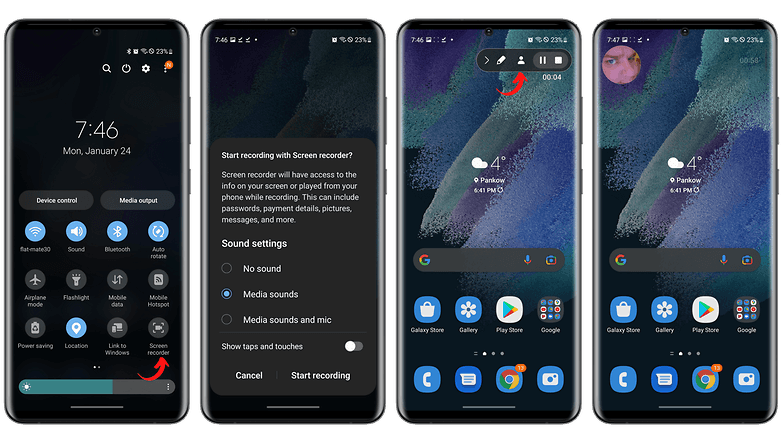
Enable gesture navigation
Gesture navigation within the user interface allows you to eliminate the smartphone’s navigation bar, revealing more space to display apps. To enable gestures on your Samsung Galaxy smartphone, simply open the Settings app and follow these steps:
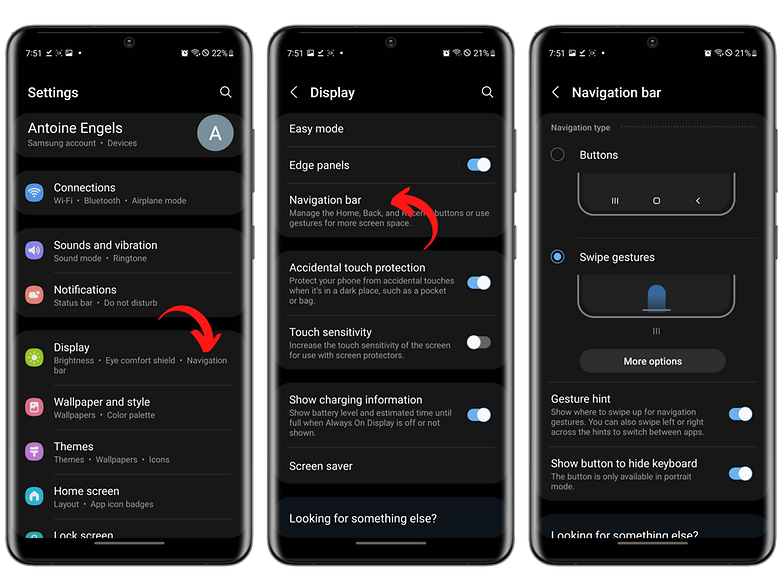
- In Settings, go to Display.
- Select Navigation Bar.
- Select Swipe Gestures.
With this setting, the navigation bar—with the buttons to switch applications, start and go back—will disappear completely and you will have to use gestures to move around the system. The Gesture Tips option displays the horizontal line that serves as a reference to the area for performing navigation gestures.
Customize dark mode
A welcome addition to the One UI for smartphones and tablets is the Dark Mode option. For devices with an AMOLED display, this feature saves battery power without having to install alternative themes. Moreover, you can program the activation/deactivation of the dark mode.
 Dark mode does contribute to visual comfort, as well as reduce power consumption on AMOLED displays. / © NextPit
Dark mode does contribute to visual comfort, as well as reduce power consumption on AMOLED displays. / © NextPit- In Settings, go to Display.
- Select Dark Mode settings.
- Tap on Turn on as scheduled.
- Customize your preferred schedule.
In the Dark Mode Settings option, you can schedule the mode to be activated only at certain times of the day, whether the setting also applies to the smartphone’s wallpaper, or whether the setting also activates the blue light filter, which promises better visual comfort.
Put some applications to sleep to preserve your battery life
I would really advise against enabling this option because Samsung kills background applications very aggressively. But if you really need a few extra percent of battery life to get through the day peacefully, then who am I to judge?
In One UI’s battery utility, you have the option to limit the background operation of certain applications according to 3 levels that determine how aggressively Samsung will “kill” them or not:
- Applications in standby.
- Applications in deep sleep.
- Applications that are never in standby.
To activate this function:
- In Settings, go to Battery and Device Maintenance.
- Tap Battery.
- Select Background usage limits.
- Enable the Put unused apps to sleep radio button.
- Choose your custom settings across 3 levels for specific apps.
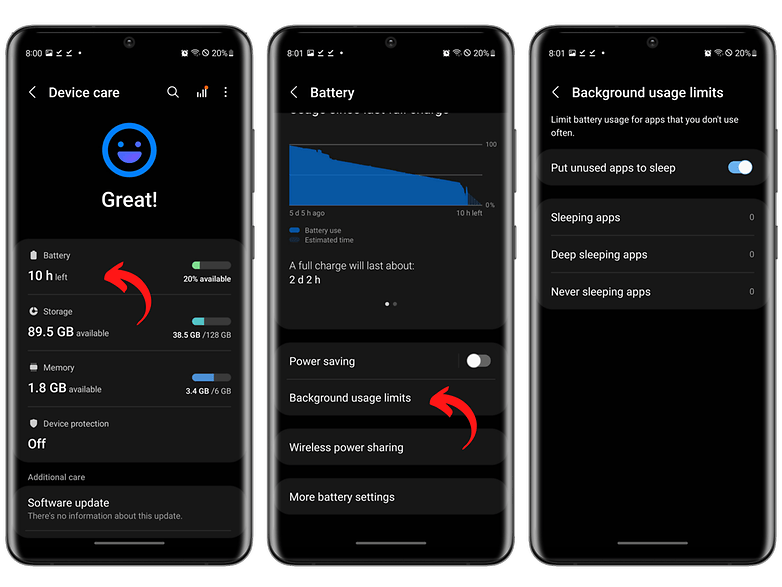
Reduce animations to increase the interface smoothness
As you probably already know, the development options in the Android operating system allow you to reduce the animations in the interface. This helps make smartphones perform faster, as the animations of closing, opening, and switching between applications are faster.
But many people don’t know that with One UI, Samsung lets you speed up the system performance even more with a simple tweak. Just open the Settings app and follow these steps:
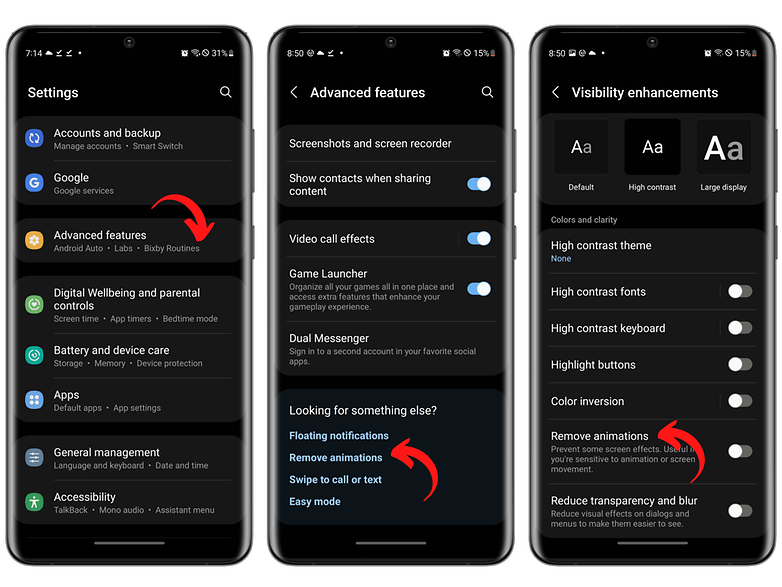
- In Settings, go to Advanced Features.
- Scroll down and select Remove Animations.
- Activate the Remove Animations radio button.
Note that this is an option that you have on almost all Android overlays, not just One UI. We also have a more detailed guide to make your Android smartphone faster by reducing animations.
How to rotate the screen on your Samsung smartphone
Yes, this trick may make some smartphone pros out there laugh. But hey, not everyone knows how to enable or disable the automatic screen rotation on a Samsung smartphone. Here are the steps to follow to activate the Rotate function that will allow you to rotate the screen of your device:
- Swipe down on the screen with two fingers to bring up the quick settings bar.
- Press the portrait icon to bring up the screen rotation.
- Alternatively, just tap Screen Rotation to avoid going into landscape mode when you rotate your smartphone.

How to unlock your Samsung smartphone without a PIN or password
There are few things more frustrating than forgetting your smartphone’s unlock code. On your Samsung smartphone, you have several options to unlock your Samsung smartphone without a PIN or password. Here is a summary of our dedicated tutorial:
Option 1: Unlock a Samsung phone with Find my Mobile:
- Open Find My Mobile in your browser.
- Login with your login details or with your Google account.
- Select the registered device on the left menu.
- Tap on the Unlock option at the bottom of the screen.
- Confirm the action by selecting Unlock.
- The procedure will delete all current PINs, passwords, patterns, and biometric protections on the device.
- Re-enter your password and select Unlock.
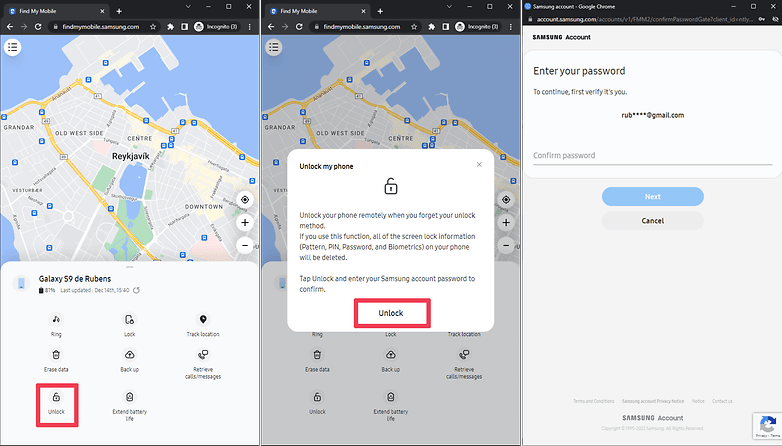
Option 2: Reset the phone via a browser
- Go to the Google Find My Device service page.
- Sign in to your Google account.
- Select the device you want to delete.
- Select Erase data to delete all data from your smartphone, including the forgotten lock code.

Option 3: Reset your smartphone without a browser
- Turn off your smartphone – Warning: All data will be lost!
- Press and hold both the Power and Volume keys to enter the reset mode.
- Navigate here with the volume rocker. With the power button, select an option.
- Choose the Recovery mode, then select Wipe data/factory reset and confirm again.
- As soon as the process is finished, your smartphone will restart and you can log in as usual with your Google account.
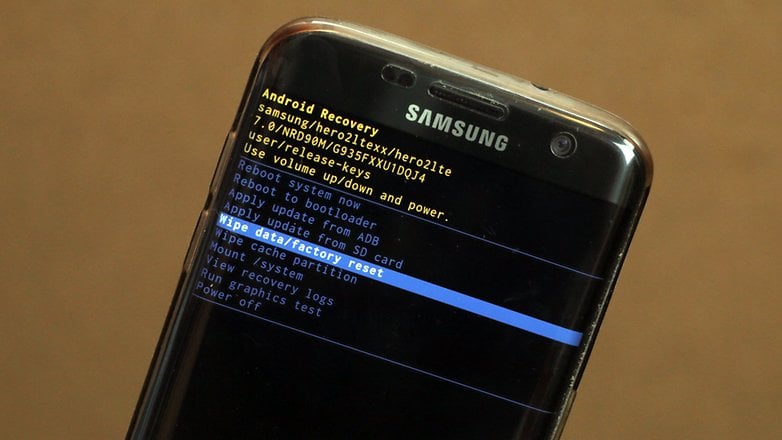
How to use the keyboard of your Samsung Galaxy as a trackpad
Typing long text on your smartphone keyboard can quickly become a pain if you often have to reposition the cursor to make corrections. Fortunately, it is possible to use your smartphone keyboard as a trackpad to quickly place the cursor in the right place. My colleague Camila shows you how to use your Samsung Galaxy keyboard as a trackpad in her dedicated tutorial.
Ain’t nobody got time for that? Follow these steps to do it on your smartphone:
- Open the Samsung keyboard.
- Long press on the space bar.
- Wait until the cursor control symbol appears on the screen.
- Move your finger on the keyboard to position the cursor at the desired editing point.
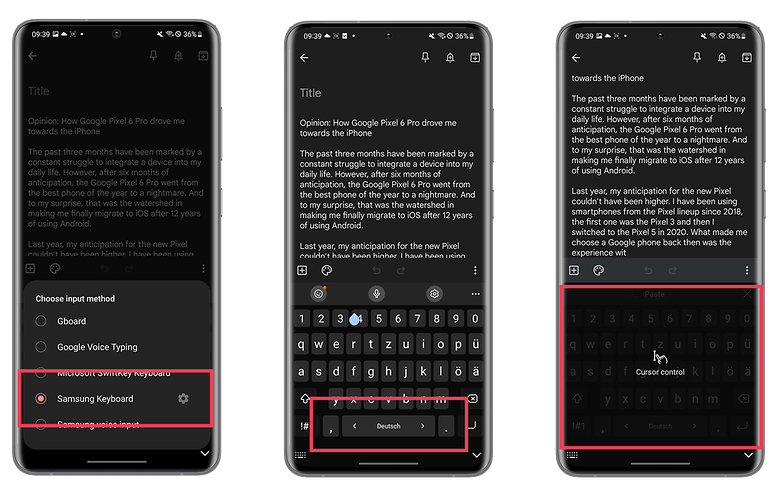
How to customize the Always-On-Display on your Galaxy smartphone
The Always-On-Display is a pretty clever feature that allows you to access essential information like the time or some notifications without having to turn on the screen of your smartphone. One UI 4.0 allows you to really customize your lock screen to display a lot of things. I invite you to read my colleague Carsten’s tutorial to learn in detail how to customize the Always-On-Display on your Galaxy smartphone.
No time? Here are the steps to follow:
- Go to the Galaxy Store and open Applications (via the navigation bar at the bottom).
- Go to the Themes section then hit Always On Display items.
- Select the AOD of your choice.
- Press Apply select Clock and Image and hit Done.
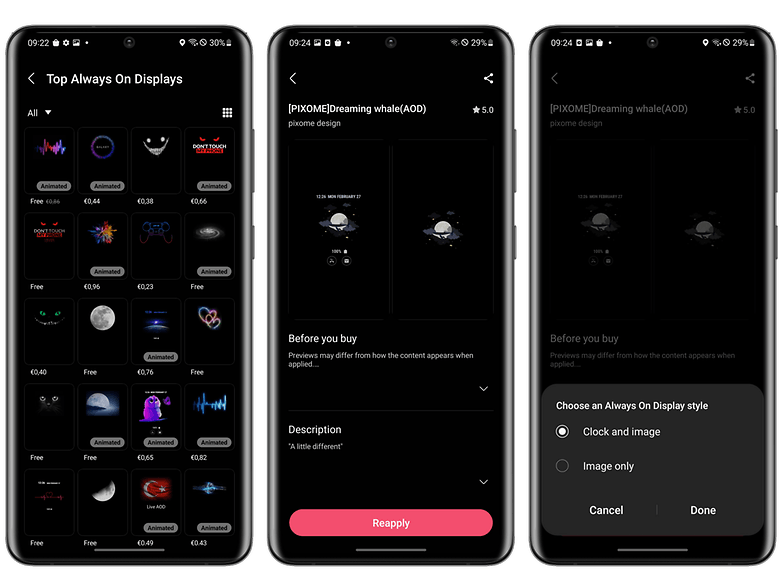
How to create a note on your Galaxy S22 Ultra very quickly
Among the many S Pen shortcuts on the S22 Ultra is one that allows you to create a note automatically as soon as you take the stylus out of its slot. I also wrote a tutorial showing how to create notes faster than your shadow on your Galaxy S22 Ultra.
Below are the steps to set up the feature of removing the S Pen to automatically create a note:
- Remove the S Pen from its slot.
- Go to the Air Command menu (if it does not appear automatically, tap the small transparent pen icon on the edge of the screen).
- At the bottom left of the Air Command menu, tap the cog-shaped Settings icon.
- In the S Pen Settings, go to the Removal section.
- Under Removal, tap When S Pen is removed.
- Select Create Note.
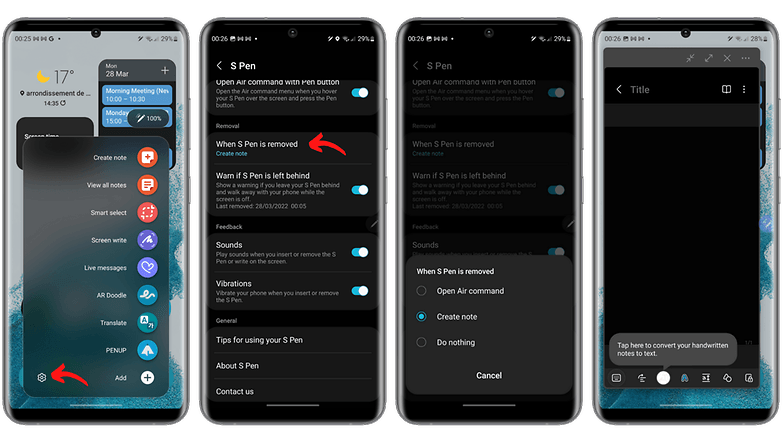
How to connect your Galaxy smartphone to your smart TV
If you want to mirror your Galaxy smartphone or tablet to a Samsung smart TV, you will need to use the Smart View feature. This feature allows you to broadcast the content of your smartphone screen to your smart TV. My colleague Rubens has written a tutorial showing you how to connect your Galaxy smartphone to your smart TV. Here is a summary of the steps:
- Open the Quick Settings menu (by swiping down from the top of the screen).
- Press the Smart View button.
- Wait for the screens to be detected and click on the device of your choice.
- Some TVs may require a pairing menu to open—see the manual for instructions.
- Confirm the screen broadcast by pressing Start Now.

Hide or block your phone number on your Galaxy phone
A rather hidden setting on the Phone app can let you hide your phone number when calling. To disable showing your number on other people’s Caller ID, follow Casi’s instructions:
- Open the Phone app.
- Tap the 3-dot icon (⋮) in the upper right corner and select Settings.
- Tap Supplementary services.
- Hit Call barring, then select Hide number.

Remove a Samsung account from your Galaxy phone
If you have added a Samsung account by accident, or created a new login and want to remove the previous one, you can follow these instructions to remove it from your Galaxy smartphone. Read this article to learn how to delete your account permanently, something that must be done on the web browser.
- Open the Settings app.
- Tap on the top tile to access the Samsung account page.
- Scroll down and tap Sign out.
- Confirm your choice.

How to create stacked widgets
This function allows you to stack several widgets in a single location, as on the iPhone. This can be very handy to help you customize your home screen without putting a billion application shortcuts and widgets. Here’s how it works:
- Add a widget (long press on the home screen > Widgets).
- Long press on an existing widget.
- In the Smart Suggestions window that just appeared, tap Create Stack.
- Choose the widget you want to stack and press Add.

Once the stack is created, you can long press on it to edit it and add or remove widgets to the stack.
Swipe to switch to split screen
Split screen mode allows you to use two applications at the same time. One UI has a gesture to quickly activate this feature. Activate this gesture by following these steps:
- Go to Settings and then to Advanced Features.
- Go to Labs.
- Activate the switch labeled Swipe for split screen.
- Swipe up from the bottom of your screen with two fingers.
Swipe to open an app in windowed mode
This is another simple but convenient gesture that makes your life easier every day. Just follow these steps to activate it:
- Go to Settings and then to Advanced Features.
- Go to Labs.
- Activate the switch labeled Swipe for contextual display.
- Swipe diagonally from the top left or right corner of your screen, then release.
How to edit a photo in the Gallery
Samsung has improved the photo editing options and the feature that allows you to remaster a photo is quite effective. Here are the steps to follow to correct your photos:
- Go to the Gallery and select a photo.
- Press the 3-dot menu icon at the bottom right of the screen.
- Press Remaster Photo.
You will then have a slider that you can drag from left to right to compare the result before and after remastering. You can restore the original by following the same procedure above. The option “restore original” will appear instead of “remaster photo”.
How to erase objects in your photos
Like Apple and Google, Samsung has created its magic eraser function to delete objects in your photos. Here’s how to use it:
- Go to the Gallery and select a photo.
- Press the pencil-shaped edit button at the bottom left.
- Press the 3-dot menu icon at the bottom right of the screen.
- Select Object Eraser.
- Select the area(s) of your photo you wish to erase.
- Press the Erase button.
You can either save the photo as a copy, to keep the original. But in any case, you will always be able to restore the original using the same process described above.
This guide highlights useful features in One UI, Samsung’s Android skin. What are your thoughts on the article and the shared tips? Did you find them helpful? Share any other useful or hidden features missing from the article in the comments!
Article updated in May 2023 with additional tricks available in One UI 5.



